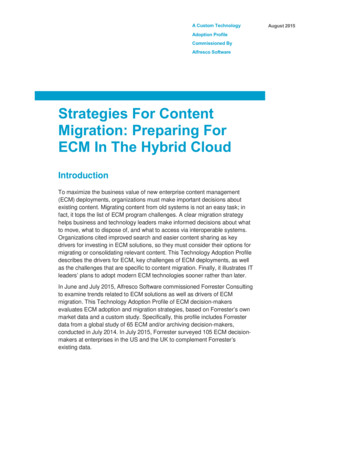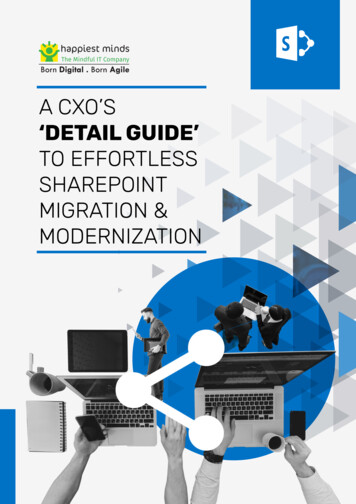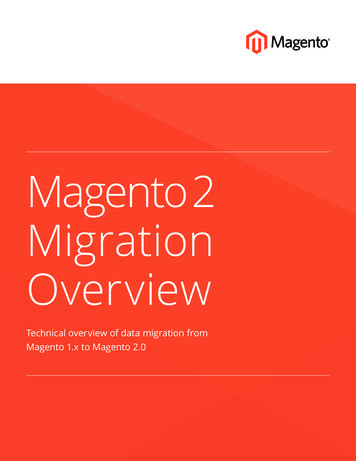
Transcription
A Custom TechnologyAdoption ProfileCommissioned ByAlfresco SoftwareStrategies For ContentMigration: Preparing ForECM In The Hybrid CloudIntroductionTo maximize the business value of new enterprise content management(ECM) deployments, organizations must make important decisions aboutexisting content. Migrating content from old systems is not an easy task; infact, it tops the list of ECM program challenges. A clear migration strategyhelps business and technology leaders make informed decisions about whatto move, what to dispose of, and what to access via interoperable systems.Organizations cited improved search and easier content sharing as keydrivers for investing in ECM solutions, so they must consider their options formigrating or consolidating relevant content. This Technology Adoption Profiledescribes the drivers for ECM, key challenges of ECM deployments, as wellas the challenges that are specific to content migration. Finally, it illustrates ITleaders’ plans to adopt modern ECM technologies sooner rather than later.In June and July 2015, Alfresco Software commissioned Forrester Consultingto examine trends related to ECM solutions as well as drivers of ECMmigration. This Technology Adoption Profile of ECM decision-makersevaluates ECM adoption and migration strategies, based on Forrester’s ownmarket data and a custom study. Specifically, this profile includes Forresterdata from a global study of 65 ECM and/or archiving decision-makers,conducted in July 2014. In July 2015, Forrester surveyed 105 ECM decisionmakers at enterprises in the US and the UK to complement Forrester’sexisting data.August 2015
2Fragmented Systems MakeContent Hard To Find, HinderingUsabilityInformation workers rely on content to communicate ideasand decisions with peers as well as with externalstakeholders, such as customers, partners, prospects,and/or regulators. Finding content and confidently sharingdata and other files with trusted collaborators has, year overyear, emerged as the top driver for adopting ECM1technologies. Businesses, however, are frequentlyburdened by the information silos that are often hard toconnect. Forrester’s ECM research shows that:›The majority of companies utilize more than one ECMsolution. In Forrester’s 2014 survey of ECM decisionmakers, 70% of firms indicated they are using two ormore ECM solutions, and 29% are using four or moresolutions (see Figure 1). This fragmentation in ECMsystems hinders usability and collaboration, which candiscourage employee adoption and impede productivity.›Organizations invest in ECM primarily to improveinformation worker productivity. Improved search is thetop reason organizations invest in ECM, followed bycontent sharing, and then improved regulatory compliance(see Figure 2). These key business drivers highlight theimportance of a user experience that is intuitive andfacilitates finding and sharing information easily, butwithout sacrificing the guardrails of security orcompromising retention policies.FIGURE 2Improved Search Tops The List Of Drivers ForECM Investments“Which of the following are the most important driversfor your organization’s investment in ECM?”(Select all that apply)Improved search69%Content sharing53%Regulatory compliance52%Consolidation of archivesFIGURE 1Most Firms Utilize More Than One ECM Solution“How many ECM solutions are currently utilized byyour firm?”42%Cost-effective automation38%Paper reduction38%Improved customer service31%eDiscovery support31%Version control22%Faster customer onboardingDo notknow5%OtherOne25%6%Base: 64 ECM and/or archiving professionalsFour ormore29%Source: July 2014 Global Enterprise Content Management And ArchivingOnline Survey, Forrester Research, Inc.70% using twoor more ECMsolutionsThree11%14%Two30%Base: 56 ECM and/or archiving professionalsSource: July 2014 Global Enterprise Content Management And ArchivingOnline Survey, Forrester Research, Inc.
3Content Migration Is A TopChallenge For Many EnterprisesWith so many organizations facing a fragmented, disparateECM infrastructure, the opportunity to modernize theirinvestments is attractive. While deployment of modern ECMsystems with cloud and mobile-friendly architectures isbecoming less complex than the first generation of ECMtools, the challenge of handling existing content is top ofmind for many decision-makers. Technology managersknow that a strategy for handling this legacy content isessential: Doing nothing is not a viable option. Our studyfound that:››Most organizations struggle with migrating legacycontent from old ECM systems. Fifty-eight percent ofrespondents cited content migration as a top challenge,followed by 57% who selected lack of coordinatedgovernance (see Figure 3). Planning, coordination, andprioritization of migration projects can become asubstantial part of an overall ECM deployment. Animmature or nonexistent strategy for informationgovernance can exacerbate challenges of migration,particularly if it is hard to determine what content isobsolete or duplicative, or if older systems have beenabandoned by their business stewards.Yet enterprises all plan to take action on legacycontent. Our survey revealed that organizations areestablishing governance frameworks to decide whatcontent to move, what to archive for long-termpreservation, what to safely delete, and what to leave inplace to be accessed via federated search orinteroperability standards. CMIS, the contentmanagement interoperability services standard, wasidentified by 47% of survey respondents as an approachto access content residing in disparate systems. None ofthe survey respondents planned to ignore content thathad not been migrated to a newer ECM system (seeFigure 4).FIGURE 3Migration Is A Major Challenge Of ECMDeployments“What are the biggest challenges facing ECM in yourorganizations today?”Migrating content from oldsystems or storage locations58%Lack of coordinated governance57%Proliferation of file shares andSharepoint49%User adoption of existingECM solutionsDifficulty integrating with otherrepositories or new businessapplicationsLack of available expertise andimplementation48%40%32%Lack of budget andexecutive support29%Cost and implementationdifficulties of ECM systems26%Proliferation of unauthorizedfile-sharing sites25%Difficult to quickly add or updateapplications with current ECMCost of annual maintenance onsoftware not deployedOther, please explain23%15%8%Base: 64 ECM and/or archiving professionalsSource: July 2014 Global Enterprise Content Management And ArchivingOnline Survey, Forrester Research, Inc.
3FIGURE 4Ninety-Three Percent Still Use Old Systems/Storage Locations, But Doing Nothing With Legacy Content IsNot An Option“Has your organization migrated legacycontent from old systems/storage locationsinto your primary ECM system(s)?”Have not migratedany content from oldsystems/storagelocationsMigrated somebusiness-criticalcontent, but majorityremains in old locationMigrated most content,but some remains inits old locationMigrated all contentinto new ECMsystem(s)7%41%“What are your plans for content that hasnot yet been migrated from old systems/storage locations?”*(Select all that apply)Migrate all content from oldsystems/storage locations toour new ECM system(s)7%58%Use content managementinteroperability standards(such as CMIS) to connectdisparate ECM systems46%Archive content to anarchive system forlong-term storageNote: Percentages do not add up to100% due to rounding.47%36%No plans to take action0%on this contentBase: 105 US and UK ECM decision-makers and influencers in IT roles*Base: 98 US and UK ECM decision-makers and influencers in IT rolesSource: A commissioned study conducted by Forrester Consulting on behalf of Alfresco Software, July 2015As ECM Shifts To Cloud, StrategiesFor Migration Become EssentialContent in the cloud is increasingly becoming part of theenterprise road map. Cloud-based content managementservices provide a distinct advantage when securecollaboration with external parties is a business driver. Yetthis path to the cloud will be one where migration decisionswill need to be made proactively. Knowledge sharing, byaccessing migrated content, is a top driver for migration,with 41% of survey respondents naming this as a key factorin their strategy. Our study found that:›Organizations will phase out on-premises systems infavor of cloud ECM for future deployments. Just overhalf of our survey respondents (52%) indicated theirprimary ECM solution resides on-premises today, with anadditional 7% using a hybrid solution encompassing cloudand on-premises. However, when we asked respondentsabout ECM plans over the next two years, 80% indicatedthey would leverage cloud solutions, such as vendorhosted, SaaS, or hybrid deployments (see Figure 5).›Security concerns and time/resource investments arethe top challenges during migration. Half of surveyrespondents (50%) selected data/content securityconcerns as a migration challenge. Additionally, 46%struggle with the time and resources needed for migratingcontent (see Figure 6). Understanding the requirementsfor sensitive content will help technology, business, andsecurity leaders make the right decisions for theirorganizations when it comes to moving confidentialdocuments to cloud platforms or leaving some forms ofsensitive content on-premises via a hybrid model.
4FIGURE 5Cloud ECM Solutions Will Overtake On-Premises Systems In The Next Two Years“How did you deploy your organization’s primary ECM solution, and what are your organization’splans for deploying ECM solutions in the future?”Installed onpremises inour data centerHosted by ourvendor in itsprivate cloudHosted by ourvendor in apublic cloudCurrent primary ECM solutionECM solution(s) planned inthe next two years52%16%33%Software-as-aservice subscriptionsolution14%13%Deployed within ahybrid on-premises/cloud environmentNow: 48% ofdeploymentsleverage cloud17% 10% 7%13%21%In two years: 80% ofdeployments willleverage cloudBase: 105 US and UK ECM decision-makers and influencers in IT roles(“don’t know”/“NA” responses not included [3% for “next 2 years”])Source: A commissioned study conducted by Forrester Consulting on behalf of Alfresco Software, July 2015FIGURE 6Security And Time Top ECM Migration Challenges“What are the challenges that your organization faces in migrating contentfrom old systems/storage locations?”Data/content security concerns50%Time and resources required to migrate thevolume of legacy content46%Complexity of business rules in legacy systems37%Lack of executive support for ECM initiatives25%Lack of organizational alignment to prioritizemigrating legacy content24%Key business processes/applications dependon content in current place24%23%Lack of business ownership of older content17%No clear business case for migrating legacy contentWe don’t have a technology solution thathelps with ECM migration6%17%Base: 105 US and UK ECM decision-makers and influencers in IT rolesSource: A commissioned study conducted by Forrester Consulting on behalf of Alfresco Software, July 2015
5ConclusionThe data from this study suggests that the challenge of coping with legacy content will continue to grow as technologymanagers plan their road maps for ECM. Today’s content landscape, for many enterprises, comprises multiple, disconnectedcontent silos, making it hard for information workers to find their documents, share them confidently, and ensure theircompany’s compliance obligations are met. As cloud and hybrid options become increasingly attractive to technologymanagers, businesses recognize the importance of their decisions about what to move, what to dispose of, and what toleave in place via federation or integration. This study illustrates that:›››Interoperability services can reduce the burden of moving legacy content. Choosing not to migrate some content isin itself a valid consideration when moving to a new ECM platform, as demonstrated by the 47% of survey respondentswho use this approach. Where the ECM technology supports interoperability standards, such as CMIS, it is feasible tofederate search or other access of older content from the user interface of the new application.Finding and sharing content are the top drivers of an ECM program. The desire to share knowledge is a top reasonfor migrating content. Successful, sustainable ECM deployments will put the requirements of busy information workersfront and center. Ease of use and the confidence to securely share documents with trusted collaborators will help driveuser engagement.Security of confidential content can present a challenge when planning migrations. Legacy systems or unmanagedfile shares may not have any current governance or oversight by stewards in the line of business. Moving this unknowncontent could be risky if access controls are not up to date. When migrating to cloud services, some organizations mayhave policy or regulatory requirements to keep some forms of content on-premises, meaning that hybrid architectures willbe required.MethodologyThis Technology Adoption Profile was commissioned by Alfresco Software. To create this profile, Forrester leveraged itsGlobal ECM survey from 2014. Forrester Consulting supplemented this data with custom survey questions asked of US andUK ECM decision-makers in IT roles. Survey respondents worked at companies in the healthcare, government, financialservices/insurance industries, have implemented ECM solutions, and have 500 or more employees. The auxiliary customsurvey was conducted in June and July of 2015. For more information on Forrester’s data panel and Tech IndustryConsulting services, visit www.forrester.com.
6Endnotes1Source: Global enterprise content management surveys conducted from 2009-2014, Forrester Research, Inc.ABOUT FORRESTER CONSULTINGForrester Consulting provides independent and objective research-based consulting to help leaders succeed in theirorganizations. Ranging in scope from a short strategy session to custom projects, Forrester’s Consulting servicesconnect you directly with research analysts who apply expert insight to your specific business challenges. For moreinformation, visit forrester.com/consulting. 2015, Forrester Research, Inc. All rights reserved. Unauthorized reproduction is strictly prohibited. Information is based on best available resources.Opinions reflect judgment at the time and are subject to change. Forrester , Technographics , Forrester Wave, RoleView, TechRadar, and Total EconomicImpact are trademarks of Forrester Research, Inc. All other trademarks are the property of their respective companies. For additional information, go towww.forrester.com. [1-UYFUQV]
favor of cloud ECM for future deployments. Just over half of our survey respondents (52%) indicated their primary ECM solution resides on-premises today, with an additional 7% using a hybrid solution encompassing cloud and on-premises. However, when we asked respondents about ECM plans over the next two years, 80% indicated











